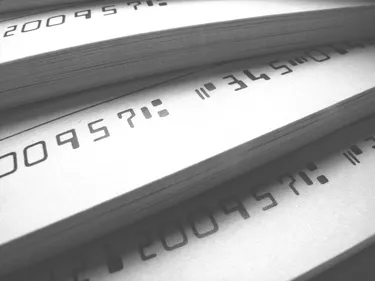
There are several reasons why you might need to know your fractional routing number (or bank fractional number). There are several factors that are used to generate this fractional number. It's only eight or nine digits long and is used to manually process checks and is a critical tool in fraud prevention and detection. It's important to be able to identify where on the check is located and what it means.
Finding Your Fractional Routing Number
Video of the Day
Banking institutions don't just have their own routing numbers; each region where that bank does business also has its own unique fractional routing number. Because the American Bankers Association issues them, it can be confusing to figure out which one is yours. You might be able to piece together check information if you know your bank's routing number and where your account is located.
Video of the Day
To locate your fractional routing number, first, you'll need a check. From there, you'll need to look at the two places where it is located. The first place is the magnetic ink character recognition strip on the very bottom of the check.
The next is at the top of the check; this is the fractional eight- or nine-digit number. Automatic check readers use the long number at the bottom of the check, while the humans manually reading the checks use the fractional routing number.
Reading Your Fractional Routing Number
Your fractional routing number isn't just a random sequence of numbers; each of the numbers is explicitly placed for a purpose. The first two or three digits of a fractional number on checks tell where the banking institution is located. Numbers 01 to 49 designate major banking centers and metropolitan areas. Numbers 50 to 99 are states arranged regionally. Some of them translate as follows: 01: New York, NY; 15: Washington, D.C.; 23: Denver, CO; 44: Topeka, KS; 50: New York state; 59: Hawaii; 68: Virginia; 88: Texas; 90: California; and 101: Guam, Puerto Rico, American Samoa and the Virgin Islands.
The following three numbers are the American Banking Association's number. Within each region, every individual bank or financial institution receives a unique three-digit number from the ABA.
After the ABA's number are the last four digits; these numbers correspond to the location from which the check originated. These are the Federal Reserve districts: 01: Boston; 02: New York; 03: Philadelphia; 04: Cleveland; 05: Richmond; 06: Atlanta; 07: Chicago; 08: St. Louis; 09: Minneapolis; 10: Kansas City; 11: Dallas; and 12: San Francisco.
Reading the Rest of Your Check
The payer's or account holder's name, address and contact information are in the top left corner. If this is your check, your name and information should be there. In the top right, you should find the check's number, as well as your fractional routing number beneath.
In the middle, there are lines for you to fill out the names of the person or organization to which you want to pay the designated amount. Underneath that is the bank's contact information, space for your memo and a signature line for you to sign. On the very bottom, you'll find the complete routing number, then the account number and then the check number (which is also in the top right).